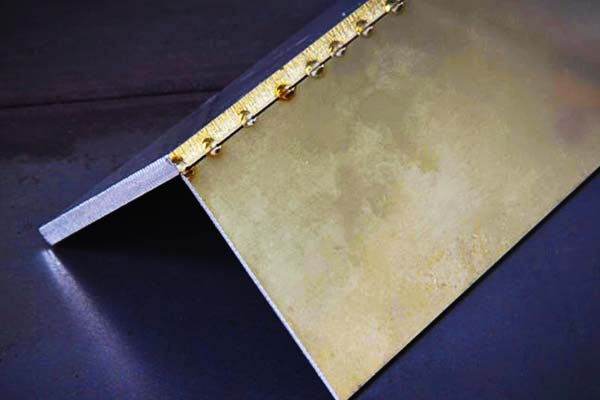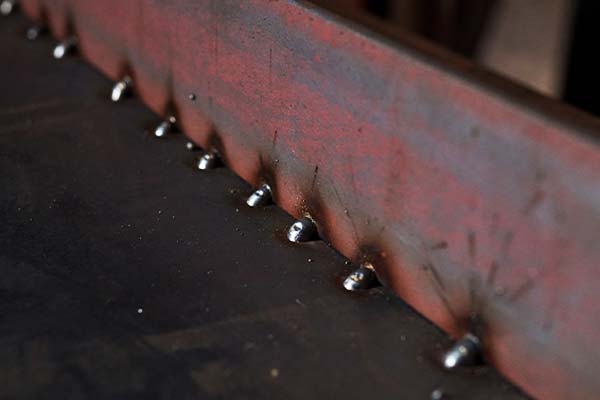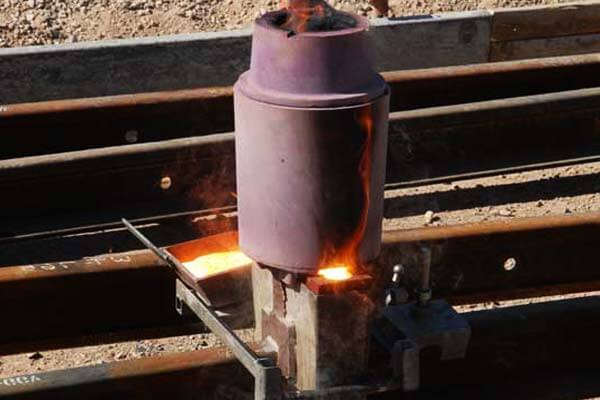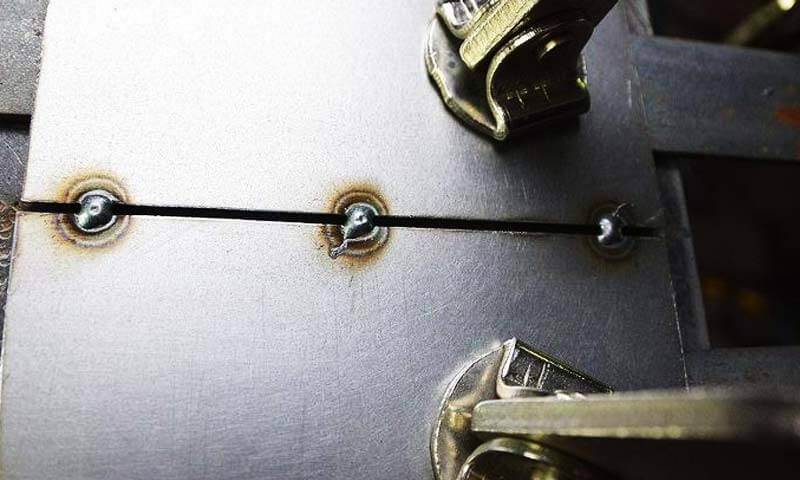1. Introduzzjoni
Welding is one of the most vital processes in manufacturing and construction, providing the foundation for creating durable and reliable joints in a variety of materials.
Kemm jekk qed tibni skajskrejper, manifattura ta' frejms tal-karozzi, jew assemblaġġ ta 'makkinarju kumpless, l-iwweldjar jiżgura s-saħħa u l-istabbiltà tal-prodott finali.
Madankollu, Il-kisba ta 'weldjaturi bla difetti teħtieġ aktar milli sempliċement l-applikazzjoni tas-sħana u l-materjal tal-mili.
Hija titlob allinjament xieraq u attenzjoni bir-reqqa għad-dettall matul il-proċess kollu.
Iwweldjar tat-tack għandu rwol kruċjali f’dan. Hija t-teknika temporanja użata biex tassigura l-biċċiet tax-xogħol f'posthom qabel il-finali, weldjatura sħiħa.
Huwa jiżgura allinjament xieraq, inaqqas ir-riskju ta' distorsjoni, u fl-aħħar mill-aħħar tikkontribwixxi għas-saħħa u l-kwalità tal-weldjatura finali.
F'dan il-blog, aħna ser nesploraw l-importanza tal-iwweldjar tat-tack, it-tekniki varji tagħha, benefiċċji, applikazzjonijiet komuni, u l-aħjar prattiki biex jiġi żgurat li l-weldjaturi tat-tack tiegħek huma stabbli u preċiżi.
2. X'inhu Tack Welding?
L-iwweldjar tat-tack huwa l-proċess ta 'applikazzjoni żgħira, weldjaturi temporanji biex iżommu biċċiet tal-metall flimkien.
Dawn il-weldjaturi huma mqiegħda strateġikament f'punti ewlenin tul il-ġonta, l-iżgurar li l-biċċiet tax-xogħol jibqgħu f'posthom matul l-istadji ta 'allinjament u assemblaġġ.
B'differenza weldjaturi finali, li huma ddisinjati biex jipprovdu saħħa fit-tul, weldjaturi tat-tack mhumiex maħsuba biex jifilħu tagħbija wara li jitlesta l-proċess sħiħ tal-iwweldjar.

Huwa huwa tipikament użat flimkien ma 'proċessi oħra ta' wweldjar bħal Iwweldjar MIG, Iwweldjar TIG, u iwweldjar b'stick.
L-iskop huwa li toħloq stabbli, bond temporanju li jiflaħ is-sħana u l-pressjoni tal-iwweldjar sussegwenti,
jipprevjenu materjali milli jiċċaqilqu jew warping matul il-ħolqien konġunt finali.
3. The Role of Tack Welding in the Welding Process
Isservi bħala l-pedament għal ħafna proġetti ta 'wweldjar akbar u aktar kumplessi.
L-għan ewlieni tiegħu huwa li jiżgura l-ippożizzjonar korrett tal-biċċiet tax-xogħol qabel ma jibda l-proċess finali tal-iwweldjar.
Dan huwa speċjalment importanti fi proġetti fuq skala kbira fejn anki allinjament ħażin minuri jista 'jikkawża kwistjonijiet sinifikanti fil-prodott finali.
Hawn kif l-iwweldjar tat-tack jgħin:
- Jiżgura Pożizzjonament Korrett: Il-weldjaturi tat-tack jassiguraw il-partijiet temporanjament f'posthom biex jipprevjenu kwalunkwe moviment waqt l-iwweldjar sħiħ.
- Jipprevjeni Warping u Distorsjoni: Billi żżomm il-partijiet fis-sod, weldjaturi ta 'tack jgħinu biex jimminimizzaw ir-riskju ta' warping ikkawżat minn espansjoni termali matul il-proċess ewlieni tal-iwweldjar.
- Ittejjeb l-Effiċjenza tal-Assemblea: Bil-partijiet allinjati sew, weldjatura tack tnaqqas il-ħtieġa għal aġġustamenti matul il-weldjatura finali, tiffranka kemm ħin kif ukoll materjali.
4. Tack Welding Techniques
Basic Steps:
- Pożizzjonament tal-Biċċiet tax-Xogħol: Ibda billi tistabbilixxi bir-reqqa l-biċċiet tax-xogħol fil-pożizzjonijiet mixtieqa tagħhom relattivi għal xulxin.
Allinjament xieraq huwa kruċjali biex jiġi żgurat li l-prodott finali jissodisfa l-ispeċifikazzjonijiet. - Proċess tal-Iwweldjar tat-Tack: Applika malajr, żibeġ żgħar ta 'weldjatura f'punti strateġiċi biex iżommu l-partijiet b'mod sikur.
Id-daqs u l-ispazjar ta 'dawn il-weldjaturi jiddependu fuq il-ħxuna tal-materjal u t-tip ta' ġonta.
Regola tajba hija li l-weldjaturi tat-tack spazjali kull wieħed 6 to 12 pulzieri, skond ir-rekwiżiti tal-proġett. - Spezzjoni finali: Qabel ma tipproċedi bil-weldjatura finali, ivverifika li l-ġonta tkun pożizzjonata sew u li l-weldjaturi tat-tack jipprovdu żamma adegwata.
L-ispezzjoni tal-allinjament issa tista 'tiffranka ħin u sforz 'l isfel fil-linja.

Common Welding Processes:
- Iwweldjar MIG: Magħruf għall-veloċità u l-effiċjenza tiegħu, L-iwweldjar MIG huwa ideali għal veloċi, weldjaturi ta 'tack effettivi fuq metalli irqaq.
- Iwweldjar TIG: Li toffri preċiżjoni u kontroll, L-iwweldjar TIG huwa perfett għal xogħol aktar delikat jew dettaljat,
speċjalment meta taħdem ma 'materjali irqaq jew jeħtieġu dehra nadifa. - Stick Iwweldjar: Bin-natura robusta tagħha, stick welding jipprovdi weldjaturi ta 'tack affidabbli għal materjali eħxen u applikazzjonijiet ta' barra fejn il-portabbiltà hija essenzjali.
Choosing the Right Size and Spacing:
L-għażla tad-daqs u l-ispazjar xierqa għall-weldjaturi tat-tack hija kritika. Ftit wisq jew żgħir wisq, u l-weldjaturi jistgħu ma jipprovdux iżżomm biżżejjed;
wisq jew kbar wisq, u jistgħu jintroduċu stress bla bżonn jew jikkomplikaw it-tneħħija.
Studju mill-American Welding Society sab li d-daqsijiet ottimali tal-weldjatura tat-tack ivarjaw skont il-ħxuna tal-materjal,
b'linja gwida ġenerali li tissuġġerixxi tulijiet tal-weldjatura tat-tack bejn 0.5 to 1 pulzier għal ħafna applikazzjonijiet.
Welding Positions:
Pożizzjonijiet ta 'wweldjar differenti — ċatti, orizzontali, vertikali, u overhead — jaffettwaw il-faċilità u l-kwalità tal-iwweldjar tat-tack.
Aġġusta t-teknika tiegħek kif xieraq biex tiżgura riżultati affidabbli.
Pereżempju, l-iwweldjar ċatt ħafna drabi huwa aktar faċli u jipproduċi weldjaturi ta 'kwalità ogħla minħabba kontroll aħjar fuq il-pool imdewweb.
5. Common Types of Tack Welding
Matul is-snin, ħarġu diversi tipi speċjalizzati ta 'iwweldjar tat-tack biex jindirizzaw applikazzjonijiet u rekwiżiti differenti.
Spot Welding
Iwweldjar fuq il-post huwa wieħed mill-aktar metodi popolari użati fix-xogħol tal-folja tal-metall, speċjalment f'industriji bħall-karozzi u l-elettronika.

Tinvolvi l-applikazzjoni ta 'pressjoni u sħana f'punti speċifiċi, normalment permezz ta 'elettrodi, biex toħloq żgħir, weldjatura lokalizzata.
- Kif taħdem: Ċirkwit elettriku ta 'kurrent għoli jgħaddi mill-biċċiet tax-xogħol fil-post fejn hija meħtieġa l-weldjatura.
Is-sħana ġġenerata mir-reżistenza fil-punti ta 'kuntatt tikkawża li l-metall jiddewweb u jingħaqad. - Applikazzjonijiet: Karozzerija tal-karozzi, elettronika, u manifattura ta' apparat.
L-iwweldjar fuq il-post huwa utli b'mod speċjali għal folji tal-metalli rqaq u materjali li mhumiex suxxettibbli għal distorsjoni termali sinifikanti. - Benefiċċji: Fast, effiċjenti, u kost-effettiv għal produzzjoni ta 'volum għoli.
Ultrasonic Tack Welding
Huwa aktar ġdid, teknika aktar speċjalizzata li tuża mewġ tal-ħoss ta 'frekwenza għolja biex toħloq sħana lokalizzata u materjali tal-weldjatura flimkien.

B'differenza mill-metodi ta 'wweldjar konvenzjonali, ma teħtieġx materjal tal-mili jew temperaturi għoljin.
Minflok, il-vibrazzjonijiet ultrasoniċi jiġġeneraw biżżejjed sħana biex jgħaqqdu l-uċuħ.
- Kif taħdem: Mewġ ultrasoniku huma applikati fi frekwenza bejn 20 u 40 kHz, li tikkawża li l-uċuħ tal-metall jivvibraw malajr, jiġġeneraw sħana frizzjonali.
Is-sħana maħluqa tgħaqqad il-materjali fil-punt tal-kuntatt. - Applikazzjonijiet: Ħafna drabi jintuża f'applikazzjonijiet fejn l-iwweldjar tradizzjonali jista 'jagħmel ħsara lill-komponenti delikati jew żgħar, bħal fl-industrija elettronika jew apparat mediku.
- Benefiċċji: Preċiżjoni u distorsjoni minima jagħmluha ideali għal applikazzjonijiet fuq skala żgħira.
Bridge Tack Welding
Iwweldjar ta 'pont tack tinvolvi l-ħolqien ta' weldjaturi ta' tack żgħar multipli tul ġo ġonta jew tul vojt bejn il-partijiet.
Din it-teknika "tgħaqqad" id-distakk qabel ma tiġi applikata l-weldjatura sħiħa, tiżgura li l-komponenti jibqgħu f'allinjament matul il-proċess kollu.
- Kif taħdem: Weldjaturi ta 'tack żgħar huma mqiegħda f'intervalli, "jgħaqqad" b'mod effettiv il-partijiet flimkien.
Dan jgħin biex jinżamm l-allinjament tagħhom matul stadji ulterjuri ta 'wweldjar jew assemblaġġ. - Applikazzjonijiet: Użat komunement fl-iwweldjar strutturali, bħal fil-kostruzzjoni ta 'strutturi kbar tal-azzar bħal pontijiet, vapuri, u makkinarju tqil.
- Benefiċċji: Jipprovdi stabbiltà eċċellenti għal komponenti kbar, jipprevjenu partijiet milli jiċċaqilqu matul il-weldjatura finali.
Hot Tack Welding
L-iwweldjar ta 'tack sħun jinvolvi ssaħħan tal-partijiet għal temperatura għolja qabel ma tapplika l-weldjatura tat-tack.
Din it-teknika tiżgura li l-biċċiet tax-xogħol huma diġà wweldjati parzjalment meta ssir it-tack,
tnaqqas ir-riskju ta 'warping jew allinjament ħażin matul il-proċess sħiħ tal-iwweldjar.
- Kif taħdem: Il-biċċiet tax-xogħol jissaħħnu sa ċertu temperatura bl-użu ta 'sorsi ta' sħana esterni bħal torċa jew forn.
Ladarba fit-temperatura mixtieqa, weldjaturi ta 'tack huma applikati f'diversi punti tul il-ġonta. - Applikazzjonijiet: Użat f'sitwazzjonijiet fejn il-materjali jeħtieġ li jinżammu f'posthom f'temperaturi għoljin jew fejn il-proċess ġenerali jinvolvi l-iwweldjar ta' sezzjonijiet ħoxnin tal-materjal.
- Benefiċċji: Ideali għall-prevenzjoni tad-distorsjoni termali u l-iżgurar ta 'twaħħil strett għal materjali akbar.
Induction Tack Welding
Iwweldjar bl-induzzjoni juża induzzjoni elettromanjetika biex jiġġenera s-sħana fil-biċċiet tax-xogħol.
Dan il-proċess ħafna drabi jintuża għal applikazzjonijiet ta 'veloċità għolja fejn huma meħtieġa ċikli ta' tisħin u tkessiħ rapidi.
- Kif taħdem: Kurrent alternanti jgħaddi minn kolja mqiegħda ħdejn il-biċċiet tax-xogħol.
Il-kurrent indott isaħħan il-metall, li jikkawżaw li jiddewweb u fjus fil-punt ta 'kuntatt. - Applikazzjonijiet: Użat komunement f'industriji li jeħtieġu tisħin veloċi u preċiż għal komponenti kbar, bħal fl-imtieħen tal-azzar u xogħol tal-metall.
- Benefiċċji: Malajr, tisħin ikkontrollat, u l-abbiltà li tapplika sħana lokalizzata preċiża għall-metall.
Thermit Tack Welding
Huwa uża reazzjoni kimika bejn metalli trab (tipikament aluminju u ossidu tal-ħadid) biex tipproduċi reazzjoni eżotermika li tiġġenera s-sħana.

Din is-sħana tintuża biex iwweldja l-materjali flimkien.
- Kif taħdem: It-taħlita tat-termite tinxtegħel u tiġġenera temperaturi estremament għoljin, biżżejjed biex iddewweb il-biċċiet tax-xogħol u toħloq rabta.
Dan il-proċess ħafna drabi jintuża biex iwweldja sezzjonijiet ħoxnin tal-metall. - Applikazzjonijiet: Użat fil-ferroviji, makkinarju tqil, u applikazzjonijiet industrijali li jeħtieġu sħana għolja u bonds qawwija.
- Benefiċċji: Estremament qawwija u ideali għall-kbar, materjali ħoxnin.
6. Benefits of Tack Welding
- Preċiżjoni u Kontroll: L-iwweldjar tat-tack jiżgura li l-komponenti jkunu pożizzjonati preċiżament qabel il-weldjatura finali,
jitnaqqas ir-riskju ta' allinjament ħażin u jiġu żgurati riżultati ta' kwalità għolja. - Distorsjoni mnaqqsa: Billi żżomm il-partijiet f'posthom, l-iwweldjar ta 'tack jimminimizza l-espansjoni termali li tista' sseħħ waqt l-iwweldjar sħiħ, li ħafna drabi twassal għal distorsjoni.
- Kosteffikaċi: Jgħin biex jiffranka kemm ħin kif ukoll materjal billi jipprevjeni l-ħtieġa għal xogħol mill-ġdid minħabba allinjament ħażin jew pożizzjonament mhux korrett.
- Assemblea Simplifikata: Hija tgħin fl-assemblaġġ ta 'strutturi kumplessi billi tassigura l-partijiet temporanjament,
li tippermetti lill-welders jiffokaw fuq aspetti importanti oħra tal-proġett.
7. Żvantaġġi ta 'Tack Welding
- Natura Temporanja: Peress li l-weldjaturi tat-tack ma jifilħux tagħbija, għandhom jew jiġu inkorporati fil-weldjatura finali jew jitneħħew wara.
- Misalignment Risks: Jekk mhux applikat bir-reqqa, weldjaturi tat-tack jistgħu jikkawżaw allinjament ħażin matul il-proċess finali tal-iwweldjar, li jirriżulta f'xogħol mill-ġdid addizzjonali.
- Żoni Affettwati mis-Sħana: Weldjaturi tat-tack multipli fl-istess żona jistgħu jikkawżaw żoni affettwati mis-sħana,
li jista’ jdgħajjef il-materjal maż-żmien jekk ma jiġix ġestit bir-reqqa.
8. Common Applications of Tack Welding
- Fabbrikazzjoni u Armar: Proġetti strutturali kbar bħal pontijiet, bini, u l-bastimenti jeħtieġu l-iwweldjar tat-tack biex iżommu l-komponenti allinjati matul il-proċess sħiħ tal-iwweldjar.
- Xogħol Sheet Metal: L-industriji tal-karozzi u tal-ajruspazju jużaw l-iwweldjar tat-tack b'mod estensiv biex jiġbru l-bodi tal-karozzi, ġwienaħ, u strutturi tal-fuselage.
- Iwweldjar tal-pajpijiet: Ħafna drabi tintuża biex tallinja u żżomm temporanjament il-pajpijiet qabel l-iwweldjar sħiħ, tiżgura li l-ġonot huma preċiżi.
- Tiswijiet u Manutenzjoni: F'ħidmiet ta' manutenzjoni, l-iwweldjar tat-tack jintuża biex iżżomm il-partijiet fil-post waqt li jsiru tiswijiet jew sostituzzjonijiet.
9. Tips for Successful Tack Welding
Choosing the Right Electrode or Filler Material
Żgura li l-elettrodu jew il-materjal tal-mili jaqbel mal-metall bażiku biex toħloq qawwi, weldjatura ta 'tack kompatibbli.
L-għażla tal-materjal it-tajjeb tista 'ttejjeb is-saħħa tal-weldjatura u tnaqqas ir-riskju ta' difetti.
Proper Heat Control
Żomm il-livell it-tajjeb tas-sħana biex tevita li żżejjed iż-żona tal-ġonta, li jistgħu jdgħajfu l-materjal jew jikkawżaw deformazzjonijiet mhux mixtieqa.
Kontroll adegwat tas-sħana jikkontribwixxi għal aktar nadif, weldjaturi ta 'tack aktar durabbli.
Maintaining Correct Spacing
Iddetermina d-daqs u l-ispazjar ottimali għall-weldjaturi tat-tack ibbażati fuq il-ħxuna tal-materjal u n-natura tal-ġonta. L-ispazjar konsistenti jippromwovi l-uniformità u l-istabbiltà fil-prodott finali.
Ensuring Strong Tack Welds
Evita weldjaturi dgħajfin jew inadegwati li jistgħu jfallu taħt stress billi tapplika sħana u pressjoni suffiċjenti iżda kkontrollati.
Weldjaturi ta 'tack b'saħħithom jipprovdu pedament sod għall-weldjatura finali, li tiżgura l-lonġevità tal-istruttura.
10. Challenges in Tack Welding
Porosity and Contamination
Evita li l-bwiet tal-arja u l-kontaminanti jidħlu fil-weldjatura billi tnaddaf il-wiċċ sewwa u tuża gassijiet protettivi xierqa.
Il-porożità tista' ddgħajjef il-weldjatura u tikkomprometti l-integrità tagħha.
Inconsistent Size
Żomm l-uniformità fid-daqsijiet tal-weldjatura tat-tack biex tiżgura prestazzjoni u dehra konsistenti.
Varjazzjonijiet fid-daqs jistgħu jaffettwaw is-saħħa u l-estetika tal-weldjatura finali.
Tack Weld Removal
Kun af meta u kif tneħħi l-weldjaturi tat-tack jekk meħtieġ, bħal meta jerġgħu jiġu pożizzjonati partijiet qabel il-weldjatura finali.
Tekniki ta 'tneħħija effiċjenti jistgħu jiffrankaw il-ħin u jipprevjenu ħsara lill-biċċa tax-xogħol.
Misalignment Risks
Oqgħod attent minn allinjament ħażin li jista 'jirriżulta minn tekniki mhux xierqa ta' wweldjar tat-tack, potenzjalment iwassal għal korrezzjonijiet għaljin.
Eżekuzzjoni bir-reqqa ta 'weldjaturi tat-tir tista' ttaffi dawn ir-riskji u tiżgura proċessi ta 'assemblaġġ aktar bla xkiel.
11. Get Your Custom Metal Parts with DEZE
Fi Dan, aħna jispeċjalizzaw fil-provvista ta 'servizzi ta' wweldjar ta 'kwalità għolja, inkluż l-iwweldjar tat-tack, biex tiżgura preċiżjoni u stabbiltà fil-partijiet tal-metall tiegħek.
Kemm jekk għandek bżonn fabbrikazzjoni fuq skala żgħira jew proġetti strutturali kbar, il-welders esperti tagħna għandhom l-għodda u l-esperjenza biex iwasslu riżultati mill-aqwa.
12. Konklużjoni
L-iwweldjar tat-tack jista 'jidher sempliċi fil-proċess ġenerali tal-iwweldjar, iżda l-importanza tagħha ma tistax tiġi eżaġerata.
Billi tassigura l-partijiet fil-post u tiżgura allinjament xieraq, l-iwweldjar tat-tack jipprevjeni d-distorsjoni u l-allinjament ħażin,
iffrankar ta 'ħin u spejjeż materjali filwaqt li ttejjeb il-kwalità ġenerali tal-weldjatura finali.
Kemm jekk qed taħdem fuq kostruzzjoni fuq skala kbira, proġetti tal-karozzi, jew inġinerija ta' preċiżjoni, il-ħakma huwa essenzjali biex jinkisbu l-aħjar riżultati.
Segwi l-aħjar prattiki deskritti f'dan il-blog biex tottimizza l-proċess tal-iwweldjar tat-tack tiegħek u tiżgura s-suċċess fil-proġett li jmiss tiegħek!



